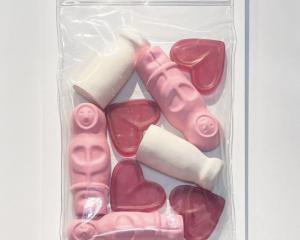•Te Huringa/Turning Points, (Dunedin Public Art Gallery)
"Te Huringa/Turning Points" is a large, impressive, and ambitious touring exhibition of works from the Fletcher Trust and Sarjeant Gallery.
Its emphasis is on the often uneasy boundaries and marriages between Maori and non-Maori traditions and cultures, especially as they relate to the colonisation of Aotearoa.
The works are specifically arranged by theme rather than by artist or chronologically, though this approach has lent a partly chronological air to the exhibition, with many of the 19th-century works linked by theme, and many of the later 20th century pieces being similarly linked.
The exhibition has been curated in such a way as to draw attention to the often subtle ways by which the attitude of the artists, be they of Pakeha or tangata whenua origin, have influenced their choice of subject or composition.
Each work is accompanied by detailed text about the piece, often allowing the viewer great insight into the art.
Even without the text, context, and subtext of the works being brought to our attention in this way, the exhibition would be well worthy of a visit.
It provides a cross-sectional artistic history lesson, and also provides us with an opportunity to view many fine works of New Zealand art.
•Touching the Unthinkable, Catharine Hodson (Dunedin Public Art Gallery)
Catharine Hodson's latest exhibition, also at the DPAG, is not for the squeamish.
A cathartic oeuvre, created in response to the artist's personal experience of breast cancer, this multimedia exhibition recreates a hospital ward through the amassing of found or created objects into small tableaux, each of which hints at an aspect of the hospital stay.
The starting point for the exhibition was Hodson's realisation that, though an important occupation, nursing is rarely encountered as a subject in art.
A photographic study of eight nurses, which forms a central element in this display, was thus a jumping-off point for the rest of the exhibition.
The centre of the gallery space is occupied by a curtained hospital bed on which is a quilt constructed from get-well cards.
Serried ranks of medicine containers stand against one wall; audio recordings of fellow cancer survivors occupy another corner.
Coincidentally, this is the second exhibition in the past few months to speak to the subject of breast cancer (Janet de Wagt's exhibition in November had a similar theme).
While Hodson's exhibition may not have the humour of de Wagt's work, its message of the loneliness of the sufferer and compassion of the carers comes across strongly in her work.
•Sheet Music (for Cheryl), Clive Humphreys (Otago Museum)
Museums are, in many ways, repositories of the lost past - historical artefacts of times past, fossil remnants of life past, snapshots of how things used to be.
This is nowhere more apparent than in traditional museum displays, such as the glass cases of stuffed and skeletal animals in Otago Museum's Animal Attic.
Clive Humphreys has used this idea as the basis for his latest exhibition.
In it, he juxtaposes two- and three-dimensional silhouettes of mundane articles with the animals that regularly occupy the display.
Music and musical instruments form a major theme of much of the exhibition, with sheet music for spiritual hymns, music stands, and musical instruments placed alongside the exhibits.
Violins, violas, and a cello sit next to sea lions (it's a shame there is no harp seal on display), and a guitar is emblazoned with fossil skulls.
There is ironic humour in many of the pieces - workshop tools sit next to a sawfish's saw-like rostrum, and Mickey Mouse is present alongside the more natural rodentia.
Central to the display are two large monochrome painted diptychs, each displaying fragments of this chaotic orchestra of lost life.








![Untitled (c. mid 1990s, [pink 3]), by Martin Thompson, 415mm×590mm. Photo: courtesy of Brett...](https://www.odt.co.nz/sites/default/files/styles/odt_landscape_small_related_stories/public/story/2024/02/untitled_pink_3.jpg?itok=Q0aQrc9o)



